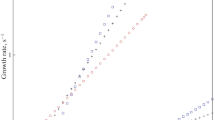Abstract
Numerous sources produce the ionization impact on the planetary atmosphere. The tropospheric cloudiness therewith is originated at such altitudes, which coincide with places of the maximum of the atmospheric ionization that caused by space radiation. Components of cosmic radiation, penetrating down to the stratospheric and tropospheric altitudes, produce in the first place the ionization of aerosols that brings to subsequent amplifying the activity of atmospheric vortices. The ionized aerosol constituent is of primary importance both in the initiation of plasma vortices and in the concentration of energy-mass by air vortices due to the humidity condensation. The ionization process is cascading, that causes the non-linear impact of penetrating rays, which amplifying with growing the air pollution. Various heterogeneities inside plasma subsystems provoke the random intensification of aperiodic electrostatic disturbances, which can exert a significant action on the development of vortices. Sometimes beaded lightning arises during thunderstorm. Using the approach of the Boltzmann kinetic equation, the characteristics of electrostatic oscillations for non-uniform plasma, are analytically derived. The analytical expressions are obtained for non-magnetized plasma. In the limits of the Earth’s atmosphere, these solutions are strictly applicable to the origination of electrostatic modulations along the lines of force of the geomagnetic field and approximately applicable in cases, when the impact of the Earth’s magnetic field is negligible. The explicit expressions are deduced both in the hot plasma approximation and in the cold plasma approximation. It is demonstrated that the formation of chain elements of discharge in hot inhomogeneous plasma is defined by the nonmonotonic distribution of charges and fields. At such conditions, the irregularities breaks up into a cellular structure.
Similar content being viewed by others
References
Arfken, G. B., & Weber, H. J. (2001). Mathematical methods for physicists. San Diego: Harcourt.
Artekha, S. N., & Belyan, A. V. (2013). On the role of electromagnetic phenomena in some atmospheric processes. Nonlinear Processes in Geophysics, 20, 293–304.
Artekha, S. N., & Belyan, A. V. (2018). New physical mechanism for lightning. International Journal of Theoretical Physics, 57(2), 388–405.
Bondur, V. G., & Pulinets, S. A. (2012). Effect of mesoscale atmospheric vortex processes on the upper atmosphere and ionosphere of the Earth, Izvestiya. Atmospheric and Oceanic Physics, 48(9), 871–878.
Bracewell, R. (1999). The Fourier transform and its applications. New York: McGraw-Hill.
Fan, J., Rosenfeld, D., Zhang, Y., Giangrande, S. E., Li, Z., Machado, L. A. T., et al. (2018). Substantial convection and precipitation enhancements by ultrafine aerosol particles. Science, 359(6374), 411–418.
Fierro, A. O., Shao, X.-M., Hamlin, T., Reisner, J. M., & Harlin, J. (2011). Evolution of eyewall convective events as indicated by intracloud and cloud-to-ground lightning activity during the rapid intensification of hurricanes Rita and Katrina. Monthly Weather Review, 139(5), 1492–1504.
Ginzburg, A. S., Gubanova, D. P., & Minashkin, V. M. (2009). Influence of natural and anthropogenic aerosols on global and regional climate. Russian Journal of General Chemistry, 79(9), 2062–2070.
Izhovkina, N. I. (2014). Plasma vortices in the ionosphere and atmosphere. Geomagnetism and Aeronomy, 54(6), 802–812.
Izhovkina, N. I., Artekha, S. N., Erokhin, N. S., & Mikhailovskaya, L. A. (2016). Interaction of atmospheric plasma vortices. Pure and Applied Geophysics, 173(8), 2945–2957.
Izhovkina, N. I., Artekha, S. N., Erokhin, N. S., & Mikhailovskaya, L. A. (2018). Aerosol, plasma vortices and atmospheric processes. Izvestiya, Atmospheric and Oceanic Physics, 54(11), 1513–1524.
Izhovkina, N. I., Artekha, S. N., Erokhin, N. S., & Mikhailovskaya, L. A. (2019). Influence of cosmic ray invasions and aerosol plasma on powerful atmospheric vortices. Physical Science International Journal, 23(2), 1–13.
Krivolutsky, A. A., & Repnev, A. I. (2012). Impact of space energetic particles on the Earth's atmosphere (a review). Geomagnetism and Aeronomy, 52(6), 685–716.
Leary, L. A., & Ritchie, E. A. (2009). Lightning flash rates as an indicator of tropical cyclone genesis in the Eastern North Pacific. Monthly Weather Review, 137(10), 3456–3470.
Mouhot, C., & Villani, C. (2011). On Landau damping. Acta Mathematica, 207, 29–201.
Nagovitsyn, Y. A. (Ed.). (2013). Solar and solar-terrestrial physics—2013. St. Petersburg: VVM Publishing House.
Price, C., Asfur, M., & Yair, Y. (2009). Maximum hurricane intensity preceded by increase in lightning frequency. Nature Geoscience, 2(5), 329–332.
Pudovkin, M. I., & Raspopov, O. M. (1992). The mechanism of the influence of solar activity on the state of the lower atmosphere and meteorological parameters—overview. Geomagnetism and Aeronomy, 32(5), 1–22.
Sinkevich, O. A., Maslov, S. A., & Gusein-zade, N. G. (2017). Role of electric discharges in the generation of atmospheric vortices. Plasma Physics Reports, 43(2), 232–252.
Veretenenko, S. V., & Tejll, P. (2008). Solar proton events and evolution of cyclones in the north Atlantic. Geomagnetism and Aeronomy, 48(4), 518–528.
Zelenyi, L. M., & Veselovsky, I. S. (Eds.). (2008). Plasma heliogeophysics (Vol. 2). Moscow: Fizmatlit.
Zherebtsov, G. A., Kovalenko, V. A., & Kirichenko, K. E. (2017). The role of solar activity in observed climate changes in the 20th century. Geomagnetism and Aeronomy, 57(6), 637–644.
Zherebtsov, G. A., Kovalenko, V. A., & Molodykh, S. I. (2005). The physical mechanism of the solar variability influence on electrical and climatic characteristics of the troposphere. Advances in Space Research, 35, 1472–1479.
Author information
Authors and Affiliations
Corresponding author
Additional information
Publisher's Note
Springer Nature remains neutral with regard to jurisdictional claims in published maps and institutional affiliations.
Rights and permissions
About this article
Cite this article
Izhovkina, N.I., Artekha, S.N., Erokhin, N.S. et al. Electrostatic Disturbances of Aerosol Atmospheric Plasma: Beaded Lightning. Pure Appl. Geophys. 177, 5475–5482 (2020). https://doi.org/10.1007/s00024-020-02568-z
Received:
Revised:
Accepted:
Published:
Issue Date:
DOI: https://doi.org/10.1007/s00024-020-02568-z




